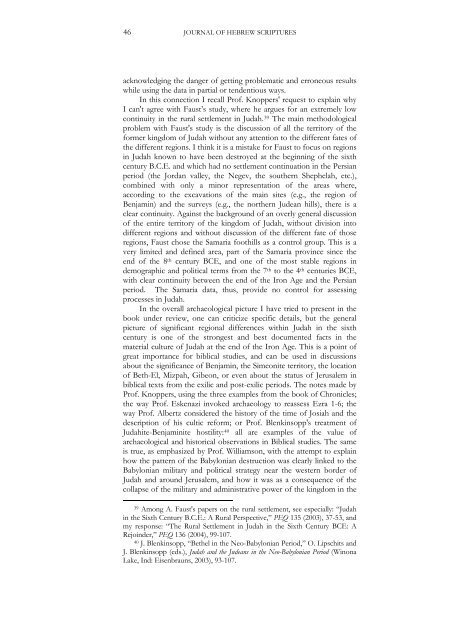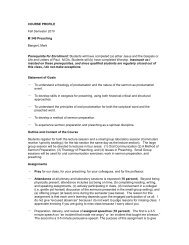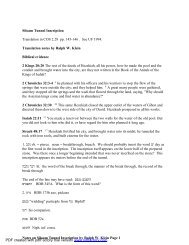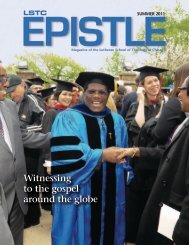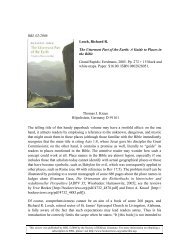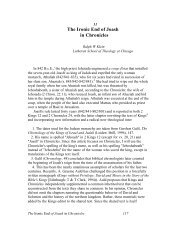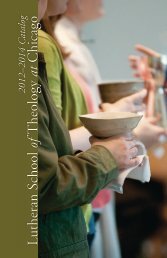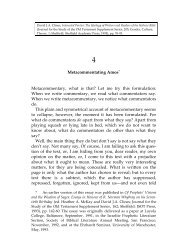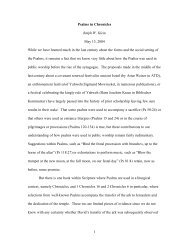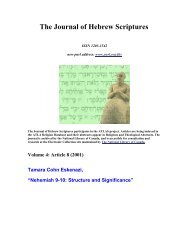Download this PDF file - University of Alberta - Journal Hosting
Download this PDF file - University of Alberta - Journal Hosting
Download this PDF file - University of Alberta - Journal Hosting
Create successful ePaper yourself
Turn your PDF publications into a flip-book with our unique Google optimized e-Paper software.
46JOURNAL OF HEBREW SCRIPTURESacknowledging the danger <strong>of</strong> getting problematic and erroneous resultswhile using the data in partial or tendentious ways.In <strong>this</strong> connection I recall Pr<strong>of</strong>. Knoppers' request to explain whyI can't agree with Faust’s study, where he argues for an extremely lowcontinuity in the rural settlement in Judah. 39 The main methodologicalproblem with Faust's study is the discussion <strong>of</strong> all the territory <strong>of</strong> theformer kingdom <strong>of</strong> Judah without any attention to the different fates <strong>of</strong>the different regions. I think it is a mistake for Faust to focus on regionsin Judah known to have been destroyed at the beginning <strong>of</strong> the sixthcentury B.C.E. and which had no settlement continuation in the Persianperiod (the Jordan valley, the Negev, the southern Shephelah, etc.),combined with only a minor representation <strong>of</strong> the areas where,according to the excavations <strong>of</strong> the main sites (e.g., the region <strong>of</strong>Benjamin) and the surveys (e.g., the northern Judean hills), there is aclear continuity. Against the background <strong>of</strong> an overly general discussion<strong>of</strong> the entire territory <strong>of</strong> the kingdom <strong>of</strong> Judah, without division intodifferent regions and without discussion <strong>of</strong> the different fate <strong>of</strong> thoseregions, Faust chose the Samaria foothills as a control group. This is avery limited and defined area, part <strong>of</strong> the Samaria province since theend <strong>of</strong> the 8 th century BCE, and one <strong>of</strong> the most stable regions indemographic and political terms from the 7 th to the 4 th centuries BCE,with clear continuity between the end <strong>of</strong> the Iron Age and the Persianperiod. The Samaria data, thus, provide no control for assessingprocesses in Judah.In the overall archaeological picture I have tried to present in thebook under review, one can criticize specific details, but the generalpicture <strong>of</strong> significant regional differences within Judah in the sixthcentury is one <strong>of</strong> the strongest and best documented facts in thematerial culture <strong>of</strong> Judah at the end <strong>of</strong> the Iron Age. This is a point <strong>of</strong>great importance for biblical studies, and can be used in discussionsabout the significance <strong>of</strong> Benjamin, the Simeonite territory, the location<strong>of</strong> Beth-El, Mizpah, Gibeon, or even about the status <strong>of</strong> Jerusalem inbiblical texts from the exilic and post-exilic periods. The notes made byPr<strong>of</strong>. Knoppers, using the three examples from the book <strong>of</strong> Chronicles;the way Pr<strong>of</strong>. Eskenazi invoked archaeology to reassess Ezra 1-6; theway Pr<strong>of</strong>. Albertz considered the history <strong>of</strong> the time <strong>of</strong> Josiah and thedescription <strong>of</strong> his cultic reform; or Pr<strong>of</strong>. Blenkinsopp's treatment <strong>of</strong>Judahite-Benjaminite hostility: 40 all are examples <strong>of</strong> the value <strong>of</strong>archaeological and historical observations in Biblical studies. The sameis true, as emphasized by Pr<strong>of</strong>. Williamson, with the attempt to explainhow the pattern <strong>of</strong> the Babylonian destruction was clearly linked to theBabylonian military and political strategy near the western border <strong>of</strong>Judah and around Jerusalem, and how it was as a consequence <strong>of</strong> thecollapse <strong>of</strong> the military and administrative power <strong>of</strong> the kingdom in the39 Among A. Faust's papers on the rural settlement, see especially: “Judahin the Sixth Century B.C.E.: A Rural Perspective,” PEQ 135 (2003), 37-53, andmy response: “The Rural Settlement in Judah in the Sixth Century BCE: ARejoinder,” PEQ 136 (2004), 99-107.40 J. Blenkinsopp, “Bethel in the Neo-Babylonian Period,” O. Lipschits andJ. Blenkinsopp (eds.), Judah and the Judeans in the Neo-Babylonian Period (WinonaLake, Ind: Eisenbrauns, 2003), 93-107.


